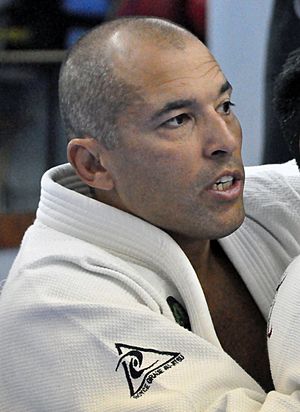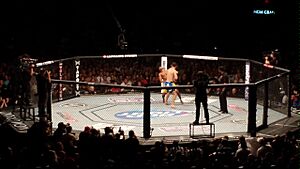Ultimate Fighting Championship facts for kids
 |
|
|
Trade name
|
UFC |
|---|---|
| Subsidiary | |
| Industry | |
| Founded | November 12, 1993 |
| Founders |
|
| Headquarters |
Las Vegas, Nevada
,
United States
|
|
Area served
|
Worldwide |
|
Key people
|
|
| Products |
|
| Services | Licensing |
| Revenue | |
|
Operating income
|
|
|
Number of employees
|
~400 (2016) |
| Parent | TKO Group Holdings |
| Divisions | UFC Apex UFC Brazilian Jiu-Jitsu UFC Fight Pass UFC Performance Institute |
The Ultimate Fighting Championship (UFC) is an American company that promotes mixed martial arts (MMA) fights. Based in Las Vegas, Nevada, it is the largest MMA promotion in the world. The UFC is owned by TKO Group Holdings.
Mixed martial arts is a sport where fighters use techniques from different fighting styles, like boxing, wrestling, and jiu-jitsu. The UFC has more than 500 fighters from all over the world. They compete in different weight classes to make the fights fair.
The company puts on events globally and follows the Unified Rules of Mixed Martial Arts. Since it started, the UFC has held over 700 events. Dana White has been the president since 2001 and has helped it grow into a company worth billions of dollars.
The UFC was started by businessman Art Davie and martial artist Rorion Gracie. The very first event, UFC 1, took place in 1993 in Denver, Colorado. The goal of the first UFC events was to see which fighting style was the most effective. There were very few rules, and fighters from different martial arts competed against each other. Over time, more rules were added, and fighters started learning multiple styles. This created the sport we now know as MMA.
In 2016, the UFC was sold to a group led by Endeavor for over $4 billion. In 2023, the UFC merged with the wrestling company WWE to form a new company called TKO Group Holdings.
Contents
History of the UFC
How the UFC Started in the 1990s

The idea for the UFC came from a tournament called "War of the Worlds." The plan was to have an eight-man tournament where fighters from different martial arts would compete. This idea was inspired by videos from the Gracie family of Brazil. These videos showed their Brazilian jiu-jitsu students beating experts in other styles like karate and kickboxing.
The creators wanted to answer the question, "Can a wrestler beat a boxer?" The first event, UFC 1, was held on November 12, 1993. It featured fighters with skills in only one martial art. One of the fighters was Royce Gracie, a Brazilian jiu-jitsu expert. He was much smaller than most of his opponents.
Royce Gracie won the first tournament by using submission holds to make his opponents give up. The show was a big hit on pay-per-view television. Because it was so successful, the creators decided to hold more events.
A unique feature of the UFC was its fighting area. Instead of a traditional boxing ring, they created an eight-sided cage called the Octagon. This was to keep the fighters from falling out and to give the event a special look. The Octagon is still the symbol of the UFC today.
Becoming a Safer Sport
In the beginning, the UFC was advertised with the line, "There are no rules." While there were a few rules, like no biting, the sport was very violent. This caused some officials to try and ban it, calling it too dangerous.
In response, the UFC began to add more rules to make the sport safer and more professional.
- At UFC 12, weight classes were introduced so fighters would face opponents of similar size.
- At UFC 14, gloves became required, and some dangerous kicks were banned.
- At UFC 15, more rules were added to ban things like headbutts and pulling hair.
- At UFC 21, five-minute rounds were introduced, just like in boxing.
These changes helped the UFC become a recognized sport. By 2000, states like California and New Jersey created official rules for MMA, which helped the sport grow.
The Zuffa Era and Growing Popularity
By 2001, the original owners of the UFC were close to going out of business. That's when brothers Frank and Lorenzo Fertitta, along with their business partner Dana White, bought the UFC for $2 million. They created a new company called Zuffa to run it.
With Dana White as the new president, the UFC slowly started to become more popular. A key moment was UFC 40 in 2002. The event featured a big fight between Tito Ortiz and Ken Shamrock. It sold many more pay-per-views than previous events and got attention from major sports channels like ESPN. Many people believe this event saved the UFC from failing.
The Ultimate Fighter TV Show
Even with some success, the UFC was still losing money. To reach a wider audience, the Fertitta brothers created a reality TV show called The Ultimate Fighter (TUF). The show featured up-and-coming fighters living and training together. They competed in fights to win a contract with the UFC.
The show first aired in 2005 on Spike TV and was a huge success. The final fight of the first season between Forrest Griffin and Stephan Bonnar is considered one of the most exciting fights in UFC history. Dana White has said that The Ultimate Fighter saved the UFC and turned it into the popular sport it is today.
Expanding Around the World
With its new popularity, the UFC began to expand. It bought other MMA promotions like World Extreme Cagefighting (WEC) and Strikeforce. This brought many talented fighters and new weight classes, like featherweight and bantamweight, into the UFC.
The UFC also started holding events in other countries.
- Canada: The first Canadian event was UFC 83 in 2008. UFC 129 in Toronto set an attendance record with over 55,000 fans.
- United Kingdom: The UFC first came to London in 2002 and has returned many times.
- Brazil: After an event in 1998, the UFC returned to Brazil in 2011 and has held many events there since.
- Australia: The first event in Australia was UFC 110 in 2010.
- Asia: The UFC has held events in Japan, China, Singapore, and other Asian countries.
This global expansion helped make the UFC a worldwide brand.
Women's MMA in the UFC

For a long time, the UFC only had male fighters. That changed in 2012 when the UFC signed its first female fighter, Ronda Rousey. She was the Strikeforce bantamweight champion and became the first-ever UFC women's champion.
Rousey was a dominant champion and became one of the UFC's biggest stars. Her success opened the door for more female fighters. In 2013, the UFC added a women's strawweight (115-pound) division. Today, the UFC has several women's weight classes, and female fighters often headline major events.
Rules of the Fight
The UFC follows the Unified Rules of Mixed Martial Arts, which are used by most MMA organizations in the United States.
Rounds
- Championship fights and main event fights are five rounds long.
- All other fights are three rounds long.
- Each round lasts for five minutes, with a one-minute rest period in between.
The Octagon Cage
UFC fights take place in an eight-sided cage called the Octagon. The cage has walls made of chain-link fence. This design keeps the fighters safe and inside the fighting area. The standard Octagon is 30 feet across. For smaller events, a 25-foot cage is sometimes used.
How a Fight Can End
A UFC fight can end in several ways:
- Submission: One fighter forces the other to give up, either by tapping the mat or their opponent, or by verbally quitting.
- Knockout (KO): A fighter is knocked unconscious by a legal strike.
- Technical Knockout (TKO): The referee stops the fight because one fighter can no longer defend themselves. This can also happen if a doctor or a fighter's corner stops the fight.
- Judges' Decision: If the fight goes through all the rounds, three judges score the fight to decide the winner.
- Disqualification: A fighter is disqualified for using an illegal move.
UFC Weight Divisions
The UFC has several weight classes for men and women to ensure fair competition. Each weight class has a champion.
Men's Divisions:
- Flyweight (up to 125 lbs)
- Bantamweight (up to 135 lbs)
- Featherweight (up to 145 lbs)
- Lightweight (up to 155 lbs)
- Welterweight (up to 170 lbs)
- Middleweight (up to 185 lbs)
- Light Heavyweight (up to 205 lbs)
- Heavyweight (up to 265 lbs)
Women's Divisions:
- Strawweight (up to 115 lbs)
- Flyweight (up to 125 lbs)
- Bantamweight (up to 135 lbs)
UFC Hall of Fame
The UFC Hall of Fame honors fighters and other people who have made important contributions to the sport. It is divided into four categories:
- Pioneer Wing: For fighters who started their careers before the year 2000, when the Unified Rules were established. Members include Royce Gracie and Ken Shamrock.
- Modern Wing: For fighters who started their careers after the Unified Rules were established. Members include Forrest Griffin and Ronda Rousey.
- Fight Wing: For the greatest and most important fights in UFC history.
- Contributor Wing: For individuals who have made a big impact on the sport outside of fighting.
Images for kids
-
Anthony Pettis at a WEC event. The WEC was bought by the UFC, bringing lighter weight classes to the promotion.
See also
 In Spanish: Ultimate Fighting Championship para niños
In Spanish: Ultimate Fighting Championship para niños










